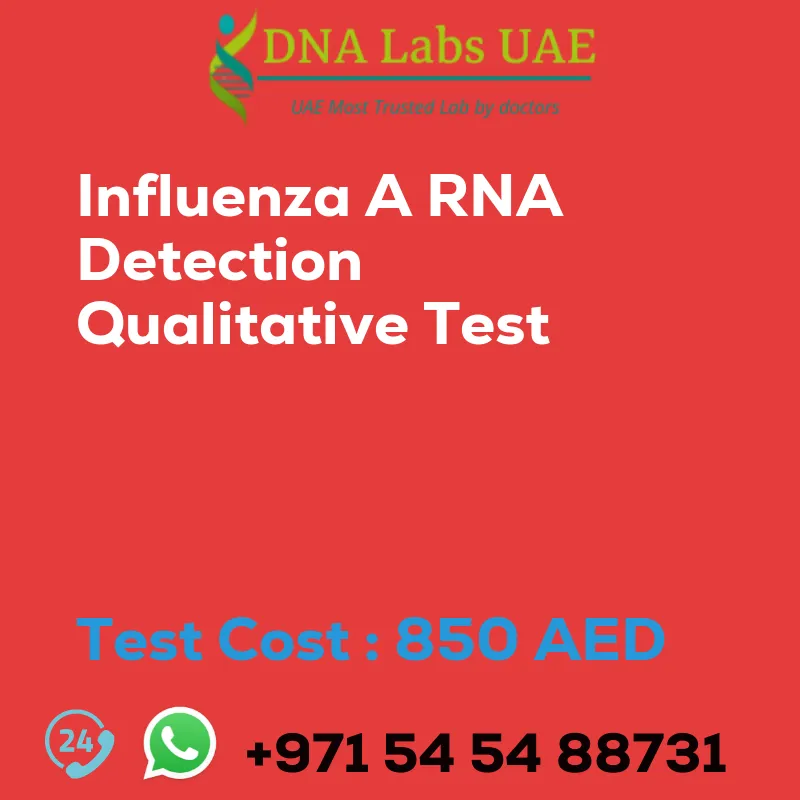Influenza A RNA Detection Qualitative Test
Test Name: Influenza A RNA Detection Qualitative Test
Components: RNA Detection Kit
Price: AED 850.0
Sample Condition: Deep nostrils (nasal swab), nasopharynx (nasopharyngeal swab), nasopharyngeal aspirate, throat or bronchial aspirate
Report Delivery: 3rd Working Day Email: 36 hours. On phone: 24 hours
Method: Real Time PCR
Test Type: Viral
Doctor: Physician
Test Department: Genetics
Pre Test Information: Consent document signature required. Bring any clinical history of patient for Influenza A (RNA Detection) Qualitative Test
Test Details
The Influenza A RNA Detection Qualitative Test is a diagnostic test used to detect the presence of Influenza A virus RNA in a patient’s sample. This test is typically performed on respiratory specimens, such as nasal or throat swabs, to diagnose Influenza A infection.
The test uses a technique called reverse transcription polymerase chain reaction (RT-PCR) to amplify and detect specific genetic material (RNA) of the Influenza A virus. RT-PCR involves converting the viral RNA into complementary DNA (cDNA) using an enzyme called reverse transcriptase. The cDNA is then amplified using specific primers and a DNA polymerase enzyme. The amplification process is repeated multiple times, which increases the amount of viral genetic material present in the sample.
The presence of Influenza A virus RNA is detected by a fluorescent probe that binds to the amplified DNA during each cycle of the PCR reaction. The fluorescence signal is measured and analyzed to determine if the sample is positive or negative for Influenza A virus.
The Influenza A RNA Detection Qualitative Test is highly sensitive and specific, providing accurate and reliable results. It can differentiate between different subtypes of Influenza A virus, such as H1N1 or H3N2.
This test is commonly used during influenza outbreaks to quickly identify infected individuals and guide appropriate treatment and infection control measures. It is important to note that this test specifically detects Influenza A virus and does not detect other respiratory viruses, such as Influenza B or respiratory syncytial virus (RSV). Separate tests may be required to identify these viruses.
| Test Name | Influenza A RNA Detection Qualitative Test |
|---|---|
| Components | |
| Price | 850.0 AED |
| Sample Condition | Deep nostrils (nasal swab), nasopharynx (nasopharyngeal swab), nasopharyngeal aspirate, throat or bronchial aspirate. |
| Report Delivery | 3rd Working Day Email:-36 hours.On phone: 24 hours |
| Method | Real Time PCR |
| Test type | Viral |
| Doctor | Physician |
| Test Department: | Genetics |
| Pre Test Information | Need to sign Consent document and bring any clinical history of patient forInfluenzaA (RNA Detection) QualitativeTest |
| Test Details |
The Influenza A (RNA Detection) Qualitative Test is a diagnostic test used to detect the presence of Influenza A virus RNA in a patient’s sample. This test is typically performed on respiratory specimens, such as nasal or throat swabs, to diagnose Influenza A infection. The test uses a technique called reverse transcription polymerase chain reaction (RT-PCR) to amplify and detect specific genetic material (RNA) of the Influenza A virus. RT-PCR involves converting the viral RNA into complementary DNA (cDNA) using an enzyme called reverse transcriptase. The cDNA is then amplified using specific primers and a DNA polymerase enzyme. The amplification process is repeated multiple times, which increases the amount of viral genetic material present in the sample. The presence of Influenza A virus RNA is detected by a fluorescent probe that binds to the amplified DNA during each cycle of the PCR reaction. The fluorescence signal is measured and analyzed to determine if the sample is positive or negative for Influenza A virus. The Influenza A (RNA Detection) Qualitative Test is highly sensitive and specific, providing accurate and reliable results. It can differentiate between different subtypes of Influenza A virus, such as H1N1 or H3N2. This test is commonly used during influenza outbreaks to quickly identify infected individuals and guide appropriate treatment and infection control measures. It is important to note that this test specifically detects Influenza A virus and does not detect other respiratory viruses, such as Influenza B or respiratory syncytial virus (RSV). Separate tests may be required to identify these viruses. |








